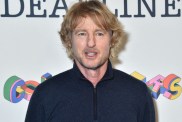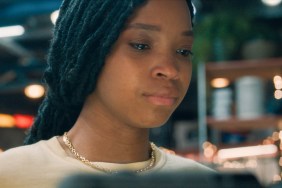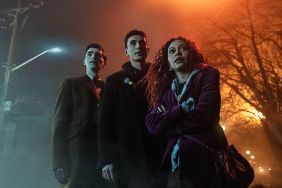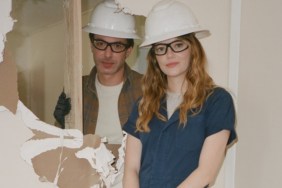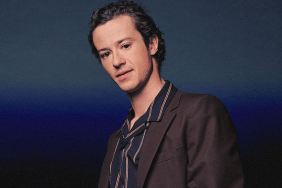The first time we saw Marshall Curry’s Racing Dreams at last year’s Tribeca Film Festival, we were blown away by how drawn we were to watching the lives of three very different kids ranging from 11 to 13 as they compete in the National Go Karting Championship.
Following the articulate Josh Hobson, the ambitious Annabeth Barnes and the troubled Brandon Warren over the course of a year, Curry created a film that’s very much a coming-of-age story at its core, capturing the innocence of youth within the highly competitive field that’s paved the way for some of the greatest racers in NASCAR. Even so, you absolutely don’t have to be a fan of NASCAR racing to enjoy the movie for the story it tells, though watching the kids drive these karts around at high speeds is certainly thrilling in itself.
Curry exploded out of the gate as a filmmaker five years ago with the excellent Street Fight about the fierce battle for the mayorship of Newark, a debut so strong it received a surprise nomination at the Oscars that year. Similarly, Racing Dreams itself has won a number of awards at various festivals, proving Curry isn’t going to be one of those doc filmmakers who only has one great doc in them.
ComingSoon.net got on the phone with the New York-based filmmaker last week to talk about the doc that hopefully more people will make an effort to check out this holiday weekend.
ComingSoon.net: Your last movie “Street Fight” takes place in New Jersey, which is very close to New York City, but the world of NASCAR is not something you really see or hear a lot about in New York, so how did you get involved in that world?
Marshall Curry: I was always sort of interested in it for that reason. I live in New York and pretty much nobody who I know in New York could name three NASCAR drivers, and yet my wife is from Charlotte, North Carolina, my parents are both from South Carolina and I got a bunch of family down there. When I go down South, it’s huge and that’s when you understand. They say it’s the second-biggest spectator sport after football. It’s bigger than baseball and basketball, and when you go down to Charlotte, you really see it. I just thought that was interesting that there can be something that’s such a huge part of my country’s culture and I don’t know anything about it. One of the cool things about making documentaries is that you get to spend a year or two learning about stuff you don’t know anything about. In the back of my mind, I always thought that maybe it would be interesting to do something about NASCAR then I read an article about these kids that race go karts that go 70 miles an hour. I thought that seemed pretty interesting and went to a few races and decided that yeah, there’s a movie in that.
CS: How long after “Street Fight” was that? ‘Cause that came out in 2005, right?
Curry: That’s right, and it sort of spilled into 2006 with the Oscar stuff. It did festivals for a while and then it was on PBS, and then it was doing foreign sales and DVD, HBO Latin America, places like that, so I was doing a lot of promotion for that. This one, I really started doing research for right after “Street Fight” and we started filming for real in January of 2007, so the movie followed the 2007 year for those kids.
CS: Were they all centrally located around that North Carolina area and is that generally where most of these young racers come from?
Curry: There are a lot there. Brandon and Annabeth are both in North Carolina, Josh is in Michigan, and the racing takes place in North Carolina, but also in Pennsylvania and Upstate New York. It is considered the national series so on that level, you have kids from all over the place who are coming to compete. But I would say that it’s the most popular in the South.
CS: So how did you find the three kids your movie follows? I guess some of them you found at the races you attended?
Curry: When I was first researching the project, I went to a couple of races and that’s where I met Josh Hobson, the super-articulate great racer, he’s like a grown-up in a child’s body. When I met him, I thought, “Oh, wow, if I can find some other kids like this than there’s definitely a story here.” I shot a little bit of test footage and cut together a trailer, shopped it around and raised the money to make the movie and then spoke to a couple people down to the awards ceremony from the previous year. We met 50 maybe 75 kids and we would just ask then, “What does your room look like?” “What do your parents do for a living?” “What kinds of books do you like to read?” Stuff that didn’t necessarily have to do with racing but would just draw out their personality and find out what kind of kids they were, and who might be interesting on camera. There were a few that popped, but those three: Josh, Anabeth and Brandon, really stood out. In fact, the awards ceremony is right next door to this giant karting convention that happens every year, and Anabeth’s opening scene where she’s signing the autographs where she explains that ever since she was a little girl she wanted to be the first woman to win the Daytona 500, that was actually the test footage that we shot of her. You can see that she’s so funny and bubbly and articulate and charming. Once we met her, five minutes later I thought, “She’d gotta be in this movie.”

CS: So you were filming right from the beginning, even as you were trying to find the right kids for the movie?
Curry: That’s right, that’s right, and then the third, Brandon, we just found later that night, so I had a conversation with him. One of the things that was interesting was trying to think about the way that the movie was going to be structured ’cause Brandon doesn’t race against Anabeth and Josh. I decided very early that I didn’t want to make another kid competition film. I mean, “Spellbound” has done it and done it perfectly. We don’t need another one. Obviously, there are a number of movies like that and so to me, at the very beginning I thought, “Okay, I’m not going to find ten kids and whittle them down to see who wins the National Go Karting series.” That’s not what I was interested in. What I really wanted to do was make a movie about adolescence and about three kids have one foot in childhood and one foot in adulthood who happen to also race go karts that go 70 miles per hour. The racing and the series provides suspense and it’s exciting to watch but even from the beginning as I was picking characters who weren’t even going to be racing against each other, I knew that this was more about characters than it will be about fitting into the kid competition (thing).
CS: What were the logistics of following all three stories? Because you do show the kids at home a lot as well as these races all over the country.
Curry: What we would do is just go and spend time with each of the kids, so we’d go spend a few days or however much time, and sometimes we would just go when we haven’t seen them in a little while and usually I would either shoot with a soundperson or I would do sounds with a (shooter) and then there would be a third person there. Everything we shot went onto cards rather than tapes, so we had to constantly dump those cards onto harddrives and back up the harddrives so we had a third person there who would hang out in the van with all the computer equipment and do all that. We would just kind of pop in and just hang out for a few days. I would be in touch with the families a lot and sometimes, I would know, say like when Annabeth and her Dad go to buy a race car, her Dad told me. “Oh, we’re thinking of going to buy a race car,” so I said “Great, I’ll be on a plane and I’ll be there to catch that,” because I thought that would be a moment. But a lot of the stuff was just hanging around and seeing what happens. We shot 500 hours of footage to make a 90 minute movie and in most of it, nothing much did happen, but all we needed was 90 minutes.
CS: I spoke to a couple of filmmakers who made a movie about the Kentucky Derby (called “First Saturday in May”) and it was amazing because they were following these horses in the year leading up to the Derby, and they had to do some reverse-engineering to figure out which horses might actually make it. You kind of lucked out because you ended up with these great kids who ended up doing reasonably well. Did you try to figure that out as well or would it have been fine if they lost or dropped out?
Curry: It definitely makes it more fun that they end up doing well, but I think if they hadn’t done well, I think it would have still been a compelling movie, but it would just be a different movie. It sort of goes back to what I was saying. Whether they did well or not, I think we would have a movie about kids struggling with having family issues and feeling romance for the first time and all of those issues that had nothing to do with who became the National Go Karting Champion.
CS: They have great personalities and you do root for them, so were you editing as you went along or did you have to wait until the end when you knew how things would end and then backtrack?
Curry: We were not really editing as we were going along but I was thinking about editing a lot as we were going along. I shoot and edit and I would think as we were going, “Okay, here’s where Anabeth’s story seems to be going, so we need to pursue this and that.” When we finally finished, each kid had 50 dead-ends and I thought, “Maybe this will be important. We need to chase this down to the very end” and some storylines turned out to not be as interesting or as significant as I thought it might be at one point, but as we were going, we were constantly talking about what is the storyline going to be for each of these kids and where is their story going to go? We were definitely thinking a lot about getting the elements that would enable us to tell the story when we got to the edit room.
CS: The narrative is very unique for a doc, maybe because you did leave it until after you had figured out the story. I know lots of doc filmmakers are editing as they go along, which must create a different dynamic.
Curry: Yeah, we edited for a year and a half and there were three editors working together on the footage, so when we were shooting, we would chase down storylines but also try not to force them. Some of my favorite material in the footage is stuff that just came out of nowhere. When Brandon called Annabeth that time and they had that phone conversation where they’re saying “Who do you like? Who do you like?” and they’re giggling and Brandon’s toes are squirming. All of that was just kind of, it’s that gold that documentary filmmakers love and I knew it as we were shooting that this was going to be one of my favorite scenes, it’s going to be one of the better scenes I’ve ever shot. I was thinking, “Oh my gosh, I’ve been on that call myself and everyone I know has been on that call themselves and yet, I’ve never seen it in a movie before.” That kind of balance between being prepared to get the beats that we need to tell the story and then just being wide open and flexible and willing to follow where the story takes you. There’s a great quote from Albert Maysles. Alfred Hitchcock had said, “In fiction films, the director is God. In a documentary film, God is the director.” I sort of liked that line and there’s obviously a lot of truth in that.

CS: The kids seem very comfortable in front of the camera, not just when being interviewed but also during these personal moments you captured. Was that just a matter of having the cameras around them a long time? Did it take them time to adjust to having your cameras around?
Curry: They were pretty quick. One of the reasons that I picked them was because all three were confident easy-going kids, so part of it was just them, part of it we just spent a lot of time with them, and the first day that we were with them, they were pretty tense. When we first go to their house, they’re all on their best behavior, but after a while, you can sort of wear people down and get them to act how they actually are. Albert Maysles also taught me once, he said, “It you point the camera at people all the time, even when it’s not on, just keep pointing the camera, because if you put it down and then when something interesting happens you pick it up, it changes the dynamic of the room. If you just tell them at the beginning ‘Most of the time when I’m pointing the camera at you I’m not even filming but you’re never going to know when I am or when I’m not so just forget about it,’ the people can be on their best behavior for an hour or two hours but six hours of having a camera pointed at you, eventually you’re going to start being who you are. The other thing I guess you can do is that we didn’t set up lights, we didn’t have a big intimidating shoulder-mounted camera. Everything was shot on a compact HD camera that was pretty new at that point. I think that the way we do sound which is mostly with wireless lavalier microphones so it’s not like we have this big boom that’s hanging over the kitchen when they’re eating dinner. I think that a lot of that stuff also goes a long way towards relaxing people.
CS: I can imagine. As far as the racing, which does play an important part in the movie, did you have to do any research to figure out how to film the racing safely? How did you go about getting what you needed in terms of coverage?
Curry: When I was shooting people at home, it was like I said, usually just me and one other person that were out there, one shooter and one audio person. When we were at the races, those races would take a full weekend. Usually they’d come in on Thursday night, they’d practice all day Friday, they’d race on Saturday and Sunday, so we would bring three crews of two and each kid would have somebody on them most of the time while they were hanging out in their trailers or just sort of goofing off or working on their go kart. Then when the race itself would happen, each of those three cameras would take up a position around the track and would get detailed shots… maybe one person would be shooting reaction shots of parents watching, somebody else would shoot Turn 1 and someone else would shoot Turn 3 and this is one situation where we did have a big HD X900 camera and a big tripod and a really strong zoom lens and that person would get up on something, either on bleachers or on the top of an RV so they could get a bird’s eye view of the race and that was the establishing shot that we could always cut back to when we were editing the races. The other things would just get the detail shots. You ask about the safety, generally everybody’s behind fences, the spectators and we were behind the fence, so that wasn’t a problem, but there is that one scene at the end of the movie where there’s that crazy crash. There’s a slow motion shot that was shot by one of our camera people and the go kart goes through the air sideways just feet from where she was standing, and it was a pretty scary moment but she was rolling and she got it. (laughs)
CS: With 500 hours of footage, did you have to watch all of it or did you have a team of people to go through it all to log it?
Curry: We had a team of people that were transcribing it, mostly interns, sort of volunteers, and that was great, so we transcribed as much as we could or at least logged it all. We tried to watch close to all of it. The races themselves took up – actually I’ve never done the math, but they took up a significant amount of the time, because for every race, that’s four cameras shooting the race so you have four times whatever the length of the race was for every single race. That could have been 50 hours right there and we didn’t need to watch every minute of those races. Somebody pretty much watched all of it, and everything was watched by one of us, and most of the footage was watched by two or more of us.
CS: Did you generally assemble the races separately, then insert them into the interviews and off-the-track stuff? That would probably have made more sense.
Curry: That’s right, and there are five races in the series, and each of them had subplots about where people qualified and what kind of engine trouble they were having and what was going on with the families and themselves at the races. When we were editing, I assumed that each of them would be a significant beat. Our initial cut of the movie was probably five hours long, and so you watch that and say, “Okay, we can’t do this.” One of the big breakthroughs was when we decided to turn Race 3 and 4 into a montage, so we just said, “Let’s just crank up the White Stripes, slap these races in there and get on with the last race.” I think that was painful; it’s always hard to kill storylines and scenes that you like but I think it made it better. I don’t think we would have sold many tickets to a five-hour movie.
CS: It’s a really tight movie and it’s a great mix of the character stuff and the races that you never really get bored, because it’s always interesting.
Curry: Thanks so much, I really appreciate that.
CS: What about the music? I saw that The National gets credited for the score, and there are a lot of their songs in the soundtrack. Did you work with them to get individual tracks or shorter versions to use?
Curry: I did. I’m friends with Matt Berninger, the lead singer, he and I worked together at an internet company before he started doing music and before I started making movies, so we’re just sort of pals. I’ve become friends with the rest of the band obviously through that as well. In some cases, we got them to lay down instrumentals, to maybe get Aaron to record the lead guitar line that carries the vocal melody or to do things like that, so they helped kind of add some material to the songs that we used in the movie.

CS: It was really interesting to see that you had instrumental versions of their songs and also things like Jet and The White Stripes, versions which just work well with your visuals.
Curry: The soundtrack I really really love. We spent a ton of time just pouring through song after song after song, trying things, and I’m really happy with how it turned out.
CS: You said it took a year and a half to edit the movie, so is that when you went back to the kids for the end of the movie?
Curry: The updates? Yeah, over the course of the editing, that’s where we’d see them get into a racecar and where we shoot that final scene with Brandon. I don’t think that was a year and a half out but it was at some point during that year and a half.
CS: Since it’s been over a year since the movie premiered at Tribeca, have you gone back to find out if they’re still racing?
Curry: Yeah, I’m in close contact with them all the time. In fact, we just had our premiere in Charlotte at the NASCAR Hall of Fame, and they brought the kids in, so all the families and the kids were together. It was fun because the NASCAR race was in Charlotte that weekend so there were a bunch of drivers that came to the screening and folks from the teams came to the screening and came to the party afterwards. It was really fun for the kids to meet some of their idols. Annabeth and Josh are both racing, they both have full-size race cars. Annabeth is racing another car called the Legend car, which is a little bit smaller than a full-size race car, but she’s practicing and testing with her full-size car, and Brandon has not been able to race, which is hard for him. He’s doing well in school and keeping out of trouble as best he can.
CS: It must have been tough for him to see the movie and not being able to race now.
Curry: I think it is, but Best Buy has a race team. AJ Allmendinger is the racer for them, and he saw the movie and really liked it, and Best Buy has come on to help us, mostly with DVD distribution but at the premiere, Best Buy gave each of the kids five thousand bucks to use towards doing some racing, so fortunately, Brandon will be able to at least race go karts again in the coming year.
CS: How did Dwayne Johnson get involved in this?
Curry: He is a partner at a company called White Buffalo, which is basically a film financing company that puts money into documentaries and independent films. Originally, the film was funded by a company called Reason Pictures, which was part of Good Magazine, so they were the ones that originally funded it, and about halfway through shooting, they brought White Buffalo on and so Dwayne is one of the partners at White Buffalo, and he became one of the executive producers at that point.
CS: So is the long road with this movie almost done and have you had a chance to think about what you want to do next?
Curry: Well, it’s almost done. We open this weekend in a number of cities and then on June 11th, we will open in New York and L.A. and D.C. so we’ll see how long it runs, but it will be over before too much longer. I have another movie that I shot at the same time as “Racing Dreams,” so I’ve been editing it and I’m hoping to have it finished this summer. It’s a documentary about a radical environmentalist who burned a couple of timber facilities in Oregon who is now in prison. Quite different from racing and inner city politics, but it’s an interesting story, too.
CS: Any idea if you’ll have that ready for Toronto this year or Sundance or Tribeca next year?
Curry: I don’t know. I probably shouldn’t even say, we’ll see. I’m hoping to have it wrapped up this summer, but these things, they just take as long as they take.
CS: It’s really amazing to watch how Cory Booker’s career has gone since your movie, because he’s done so much for Newark as the Mayor since then.
Curry: Isn’t it crazy? I can’t believe it. I sent him an Email the other day right after his reelection and said, “It seems like a long way from ‘Street Fight'” and he said, “Nah, I feel like ‘Street Fight’ was just yesterday.”
CS: Every doc filmmaker I talk to has the narrative or drama they want to direct down the road. Is that something you’ve thought about also or have you been too busy with these movies, you haven’t thought of that?
Curry: I don’t know. I love docs and actually, I know there are some folks who get into docs as a stepping stone to feature film, but I really love docs. I love making them a lot, so to me, I would be interested in doing something fictional at some point, but I haven’t found just the right project.
CS: I was wondering because I feel that this movie has such a good narrative that’s different from the normal doc formula.
Curry: Yeah, I dunno. I guess I’d just have to find the right story, but I think it would be interesting, but I guess again, I love docs, too, and I love trying to make a movie that feels like a fiction movie out of a documentary. None of these families that we filmed had ever seen documentaries before. Annabeth’s mom always used to say, “I don’t understand how you’re going to use all this footage. Is someone going to narrate it or what’s going to happen?” I would say, “No, hopefully, it’ll just play” and when I finally took it to them to watch for the first time, she said, “That’s not a documentary, that’s just a movie.” To me, that’s the highest praise you can have as a documentary filmmaker is that what you’ve made does not feel like a documentary at all. I do think a lot about that is just trying to make a documentary feel like it’s not professors in tweed jackets sitting in front of bookshelves and doing lectures. It’s characters living out dramatic and complicated stories, that’s kind of the goal.
Racing Dreams is now playing in select cities in Alabama, Arkansas, Florida, Georgia, Michigan, North and South Carolina, Tennessee and Texas, plus it opens in Indiana on Friday, May 28 and in New York on July 9 and Los Angeles on July 23. You can see the full release schedule and theaters on the official site.

